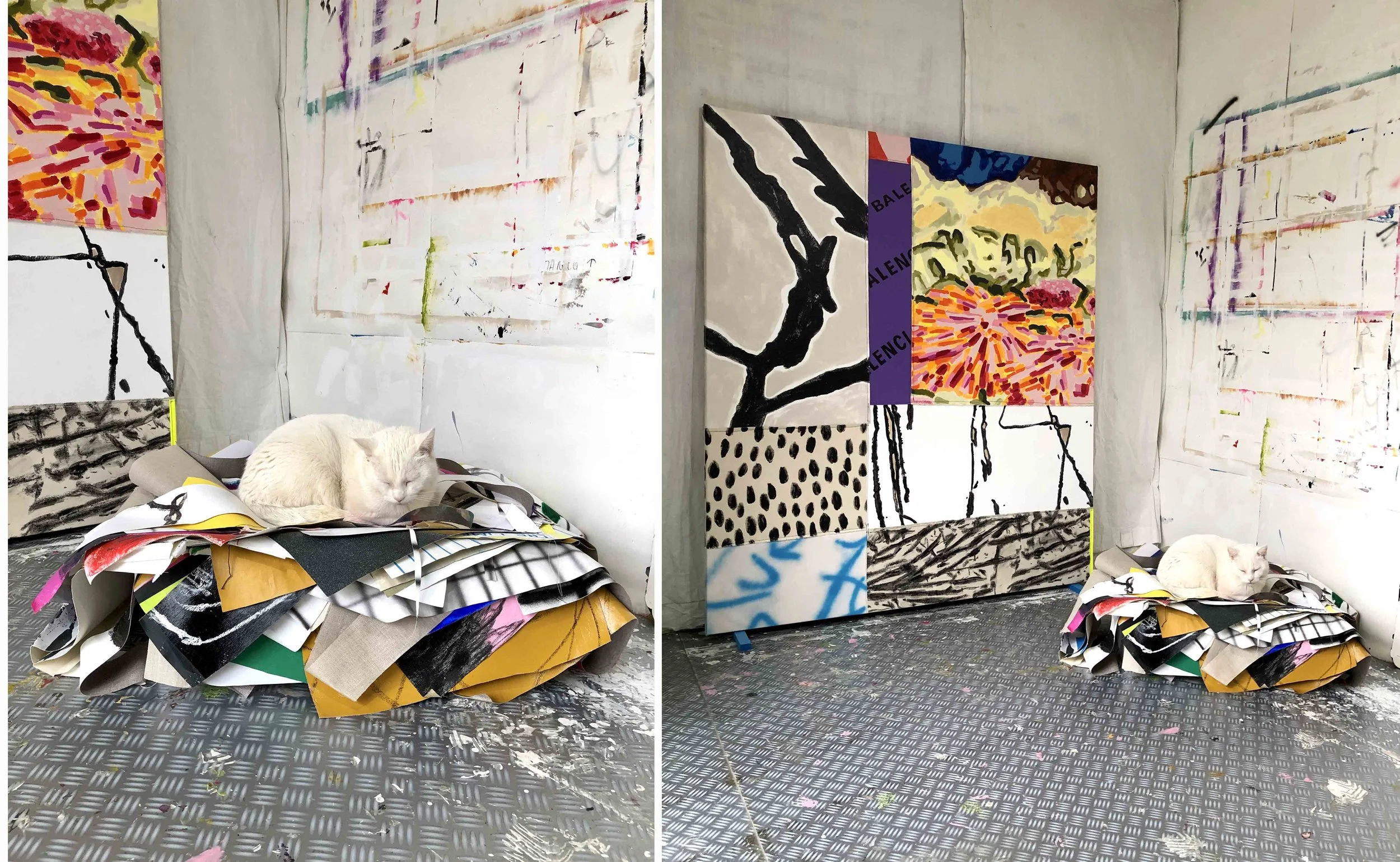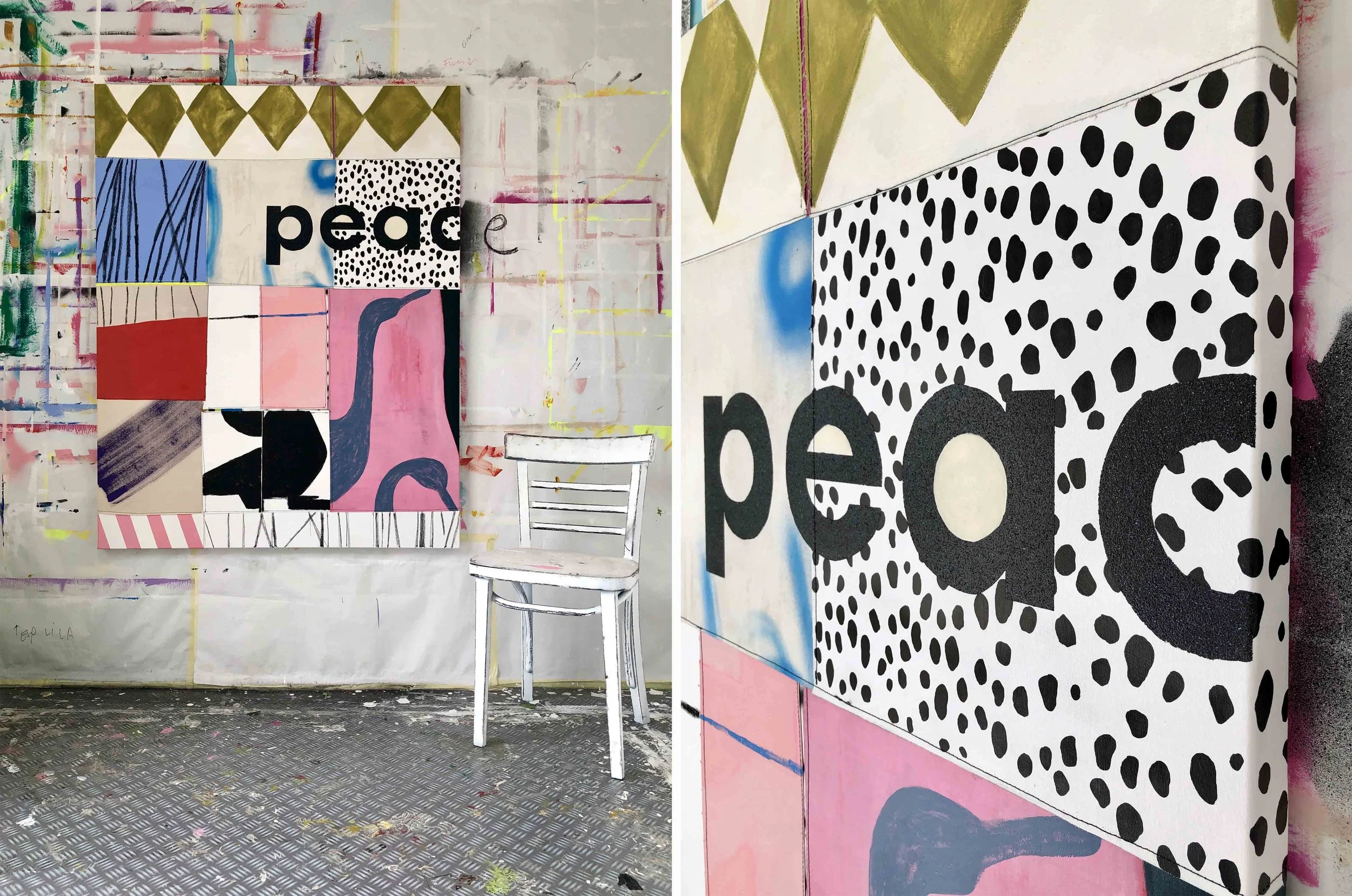“I work with painting as a space where intimate gestures, digital memory, and contemporary fragmentation come together. I’m interested in the tension between what we choose to share and what we keep hidden, the images we save as drafts, private archives, or unfinished thoughts. Through fragments -lines, stains, found shapes- I build hybrid surfaces that feel like visual diaries, always in a state of construction and collapse. Painting, for me, is a way to assemble, collect, and let go all at once; a place to hold what can’t quite be held. My work invites a slower kind of looking, one that resists the speed and constant scrolling of digital culture. I want viewers to move around the paintings, find hidden layers, and let the story shift depending on where they start. ”
Nadia Jaber is a Spanish-Palestinian contemporary artist whose work navigates the intersections of digital memory and painting. Her practice conceives painting not merely as medium but as a conceptual and philosophical space, shaped by the thought of Jacques Derrida and Roland Barthes. Drawing on Derrida’s notion of différance, where meaning is perpetually deferred and unstable, and Barthes’ idea of the artwork as a “tissue of quotations,” she approaches each painting as a living text: open, unstable, and in constant negotiation with its references. In this deconstructive spirit, her works resist closure or fixed meaning, unfolding instead as mutable constellations of fragmented signs, visual echoes, and cultural residues.
Her latest series Swipe for the details embodies this approach through the assembly of fragments from classical and contemporary paintings, meticulously stitched and recomposed into hybrid surfaces. Here, the act of “swiping” evokes both the physical gesture of digital consumption and the conceptual movement of deferral, prompting a continuous renegotiation of meaning. These works jump between textures, flip tabs into new color palettes, and stretch materiality - as if the paintings themselves were rapidly browsing visual histories. Jaber riffs between styles and ideas, cutting and scratching them like a DJ, curating something entirely new. The result is a dynamic space of tension and multiplicity, echoing Derrida’s dismantling of binary oppositions and Barthes’ idea of the death of the author, while also engaging with the hyperactive image intake that defines contemporary visual culture.
In Floral Arrangements she reimagines traditional still life as a site of impermanence and perpetual decomposition. The floral motifs become fragile constructs, always on the verge of disintegration. This embrace of ephemerality questions the possibility of capturing or preserving any fixed essence, underscoring Derrida’s assertion that presence is always haunted by absence, and that every sign carries within it the trace of what it is not.
Her series About:blank extends this critical inquiry into the realm of digital culture. The blank surface is not a void to be filled but a charged field where meaning is both possible and perpetually withheld. In these works, Jaber reflects on the algorithms behind social media - the invisible architectures shaping our desires and attention - and positions herself as a kind of postdigitalist algorithm, an online magpie curating found lines, shapes, and colors to generate an analog remix of the endless digital stream. In dialogue with Hito Steyerl’s notion of the “poor image”, her paintings become full-scale rebellions against the smoke and mirrors of online culture; their tactile surfaces demand to be experienced slowly, from every angle, revealing narratives that shift each time depending on where the viewer begins.
Her distinctive style merges precise, almost surgical brushwork with visible seams and layered fragments. By weaving together techniques traditionally associated with craft and digital logic, she creates a visual language that is at once intimate, rebellious, and rigorously conceptual.
Nadia Jaber lives and works in Barcelona. Her work has been has been featured in “15 Emerging Female Artists To Invest in Before They Blow Up” selected by Saatchi Art Head Curator Rebecca Wilson, and her paintings have been included in interior design projects featured in AD Spain Magazine and Maison Créative Magazine. Through her deconstructive approach, she invites viewers to experience painting not as a finite, resolved object, but as a dynamic process of becoming. A field of traces, absences, and infinite possibilities.
“411 Length Required” follows a deconstructivist approach, combining elements from past works, sketches, and structural experiments. Like the cat’s makeshift bed, it’s composed through intentional layering and reconfiguration.
The image on the left shows the work “510 Not Extended” in its early assembly, stitched canvas fragments coming together like a patchwork of intentions. On the right, a closer view reveals the tactile logic of the piece: layered textures, sprayed stencils, and overlapping gestures that echo the way digital memory stores, distorts, and recomposes.
Left: assembling stitched canvas fragments on the sewing machine. Right: the finished work “Tan platónico que duele” installed, the seams between its parts still visible, carrying the memory of its making.



